
Halgerda willeyi
Eliot, 1904
Order: NUDIBRANCHIA
Suborder: DORIDINA
Family: Dorididae
DISTRIBUTION
Tropical Indo-West Pacific.
PHOTO
Koumac, New Caledonia, October, 1993.
Photo: Bill Rudman.
-
Eliot, C.N.E. (1904) On some nudibranchs from East Africa and Zanzibar. Part III. Dorididae Cryptobranchiatae, I. Proceedings of the Zoological Society of London, 1903(2): 354-385, Pls. 32-34.
-
Rudman, W.B. (1978) The dorid opisthobranch genera Halgerda and Sclerodoris from the Indo-West Pacific. Zoological Journal of the Linnean Society, 62: 59-88.
Rudman, W.B., 1998 (June 17) Halgerda willeyi Eliot, 1904. [In] Sea Slug Forum. Australian Museum, Sydney. Available from http://www.seaslugforum.net/find/halgwill
Related messages
Halgerda willeyi from Saudi Arabia
July 22, 2008
From: Gert Van Roey
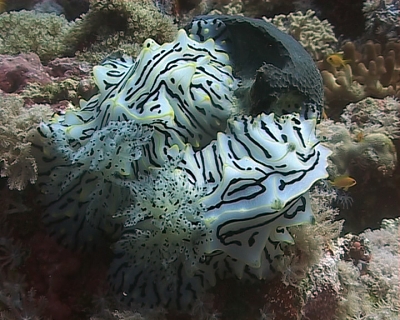
Hello Bill,
I was in Saudi Arabia last week. I saw there on Dohra island two giant Halgerda willeyi. Between 25 and 30 cm.
Greetz,
Gert Van Roey
Belgium
bakker.gert@skynet.be
Van Roey, G., 2008 (Jul 22) Halgerda willeyi from Saudi Arabia. [Message in] Sea Slug Forum. Australian Museum, Sydney. Available from http://www.seaslugforum.net/find/21729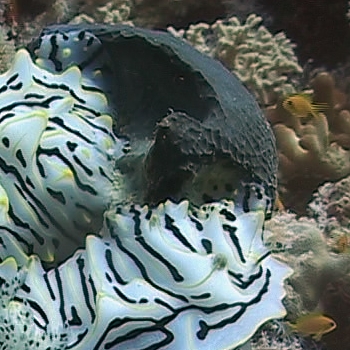
Dear Gert,
Thanks for this record. At about 30 cm these are definitely quite large animals. I don't know if you realised, but your photo has captured these animals feeding. If you look at the dark grey sphere behind them you will see a great cavity which has been eaten out by one or both of these nudibranchs. We know very little about the biology of most nudibranchs so a piece of information like this is very valuable. I can't identify the sponge off-hand but if sometime in the future a researcher is investigating the food of this genus it will be a useful clue.
Best wishes,
Bill Rudman
Colour variations of Halgerda willeyi
September 8, 2007
From: Gary Cobb

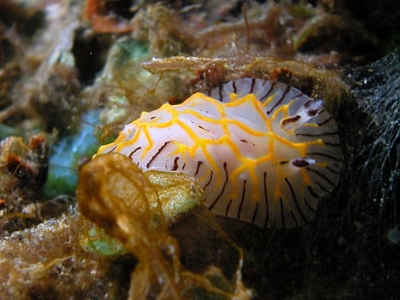
Hi Bill and everyone!
I want to present to you a composite shot I put together with two entirely different Halgerda willeyi specimens. Here on the Sunshine Coast this species his very variable.
Locality: Sunshine Coast near Mooloolaba, 10-20 m, Queensland, Australia, Pacific Ocean, 10 June 2007, Subtidal. Length: 16-60 mm. Photographer: Gary Cobb.
Cheers
Gary Cobb
gary@nudibranch.com.au
Cobb, G.C., 2007 (Sep 8) Colour variations of Halgerda willeyi. [Message in] Sea Slug Forum. Australian Museum, Sydney. Available from http://www.seaslugforum.net/find/20454
Dear Gary,
These pair certainly have the black band around the middle of the rhinophore club which I have said before seems to separate H. willeyi from H. elegans but on looking through many photos I can't say I am 100% sure that this is not a variable character. The general colour pattern of the lower animal in your composite photo is identical to that of H. elegans, which would seem to sugest that H. elegans is just a colour form of H. willeyi.
If this species is quite common on the Sunshine Coast it would be interesting to get a range of photos showing variability in overall mantle colour pattern and also rhinophore colour pattern.
Best wishes,
Bill Rudman
Halgerda johnsonorum? at Pulau Aur, Malaysia
August 11, 2007
From: Yap Ting Wee
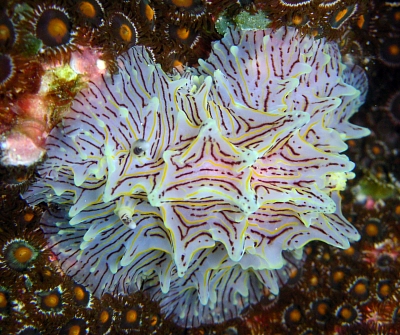
Hi Bill,
I found this species of Halgerda in Pulau Aur/Dayang, West Malaysia on 23 June 2007. I was told it was Halgerda willeyi, but it looks more like H. johnsonorum to me. Please help me to confirm which of this it belongs to.
Locality: Pulau Aur, 15m, West Malaysia, South China Sea, 23 June 2007, Hard Corals. Length: 2 inches. Photographer: Yap Ting Wee.
Regards,
Yap Ting Wee
wee_44@msn.com
Yap Ting Wee, 2007 (Aug 11) Halgerda johnsonorum? at Pulau Aur, Malaysia. [Message in] Sea Slug Forum. Australian Museum, Sydney. Available from http://www.seaslugforum.net/find/20137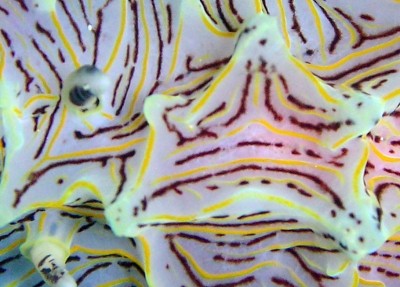
Dear Wee,
I haven't seem many illustrations of H. johnsonorum but it seems that that species has yellow lines only on the ridges and does not have the high ridges and tubercles found in your animal. I am pretty sure your animal is H. willeyi.
Best wishes,
Bill Rudman
Halgerda willeyi from Iriomote Is., Japan
April 5, 2007
From: J.R. Pahlano Daud
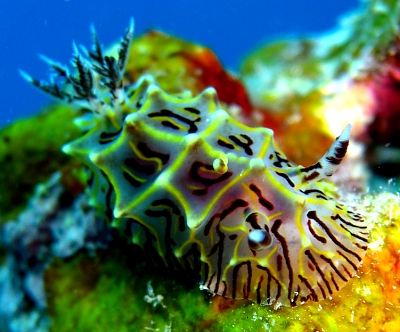
Concerning message #2012:
Hi Bill,
I just want to make sure is this Halgerda elegans... I took it from 9 meter depth at Iriomote island, Okinawa - Japan
Locality: Iriomote, 9 meter, Okinawa, Pasific Ocean, 5 December 2006, Coral Reef. Length: 4 cm. Photographer: JR. Pahlano Daud.
J.R. Pahlano Daud
pahlanoo@yahoo.com
Daud, J.R.P., 2007 (Apr 5) Halgerda willeyi from Iriomote Is., Japan. [Message in] Sea Slug Forum. Australian Museum, Sydney. Available from http://www.seaslugforum.net/find/19449Dear Jusak,
The black lines in the central part of the mantle would suggest this is H. willeyi rather than H. elegans.
Best wishes,
Bill Rudman
Halgerda willeyi from the Kermadec Ids
April 29, 2006
From: Ian Skipworth
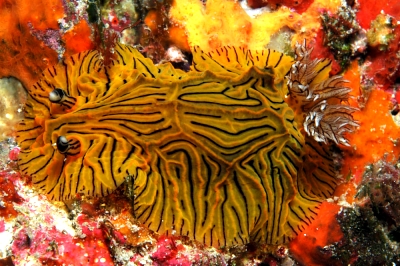
Hi
Here's Halgerda willeyi (I think) from The Kermadecs.
Locality: Napier Island, near Raoul Island, Kermadec Islands, 12m, New Zealand, Pacific Ocean, 20 March 2006, Rocky reef. Length: 40 mm. Photographer: Ian Skipworth.
Cheers
Ian Skipworth
ianskip@xtra.co.nz
Skipworth, I.R., 2006 (Apr 29) Halgerda willeyi from the Kermadec Ids. [Message in] Sea Slug Forum. Australian Museum, Sydney. Available from http://www.seaslugforum.net/find/16432Dear Ian,
This certainly looks like H. willeyi. For those not familiar with the Kermadec Islands, they are about 1000k NE of New Zealand and volcanically active, lying on the edge of the Kermadec Trench, where the Pacific Plate buries itself under the Australasian Plate. Their fauna is a mixture of northern New Zealand and local endemics, and Pacific tropical species.
Halgerda willeyi has been reported from the Kermadecs, (Brook, 1998) but it is good to get a photographic record
-
Brook, F.J. 1998: The coastal molluscan fauna of the northern Kermadec Islands, southwest Pacific Ocean. Journal of the Royal Society of New Zealand, 28: 185-233.
Best wishes,
Bill Rudman
Halgerda willeyi ? from the Red Sea
December 2, 2005
From: Joseph De Vroe
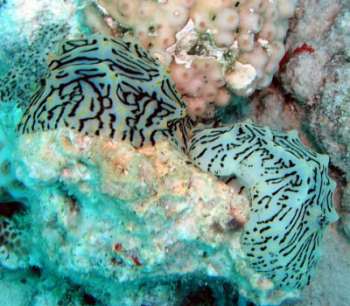
Hi Bill,
I think these are Halgerda willeyi. Am I right ?
Locality: Bluff Point (Gobal), Egypt, Red Sea. Depth: 10 m. Length: 4 cm. 10 April 2005. Photographer: Joe DE VROE
Kind regards,
Joe
joe.devroe@skynet.be
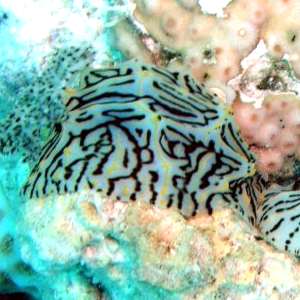
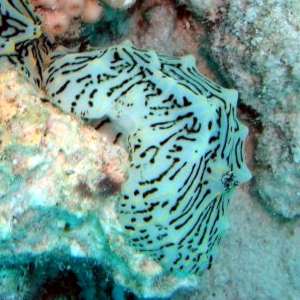
Dear Joe,
I am pretty sure this is H. willeyi. It ceratinly looks like an animal I studied from Jeddah, Saudi Arabia (Rudman, 1978). There are very few records of this species from the Red Sea, or anywhere in the Indian Ocean so this is a useful addition to our knowledge. It is interesting to compare it with the photo in Tom Turk's message [#3301] of a very similar looking 'out-of-place' animal in the Adriatic.
Best wishes,
Bill Rudman
Halgerda willeyi from Myanmar
March 26, 2003
From: Mary Jane Adams
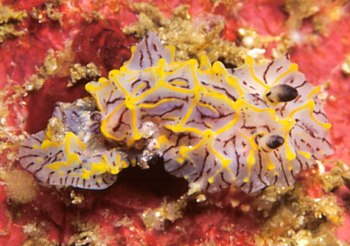
Hi Bill,
I think this poor little mangled slug is Halgerda willeyi. It seems to be surviving despite being bitten almost in half and losing all it's gills.
Length: 15mm,
Depth: about 10 meters,
Divesite: Three Islets, Andaman Sea, Myanmar.
Date: Feb. 27, 2003.
Best regards,
Mary Jane
divepng@yahoo.com
Adams, M.J., 2003 (Mar 26) Halgerda willeyi from Myanmar. [Message in] Sea Slug Forum. Australian Museum, Sydney. Available from http://www.seaslugforum.net/find/9414Thanks Mary Jane,
Nudibranchs can certainly be great survivors
Bill Rudman
Halgerda willeyi from Lord Howe Island
January 29, 2003
From: W.B. Rudman
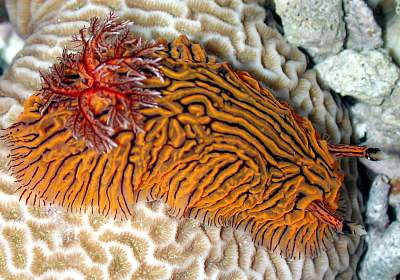
Here is a photo record from Ian Hutton of Halgerda willeyi from Lord Howe Island.
Location: Middle Beach.
Bill Rudman
Rudman, W.B., 2003 (Jan 29) Halgerda willeyi from Lord Howe Island. [Message in] Sea Slug Forum. Australian Museum, Sydney. Available from http://www.seaslugforum.net/find/8965Halgerda willeyi from Jervis Bay, eastern Australia
November 22, 2002
From: Allan Saben
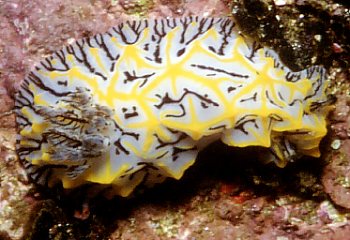
Bill,
Here is a photo of Halgerda willeyi taken in Jervis Bay, NSW, in 2001. Depth: 32 meters
Allan
asaben@bigpond.net.au
Saben, A., 2002 (Nov 22) Halgerda willeyi from Jervis Bay, eastern Australia. [Message in] Sea Slug Forum. Australian Museum, Sydney. Available from http://www.seaslugforum.net/find/8430Dear Allan,
Thanks for the photo. Have a look at my comments about an earlier photo from Jervis Bay. There seems to be a distinct colour variant found in the cooler warm temperate waters of New South Wales far south of the tropical waters in which it normally lives.
Best wishes,
Bill Rudman
Halgerda from the Philippines
October 18, 2002
From: Erwin Koehler
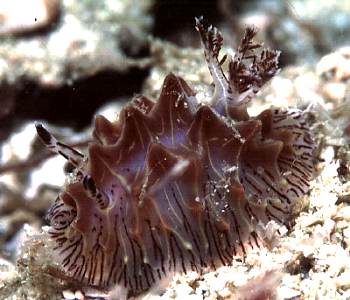
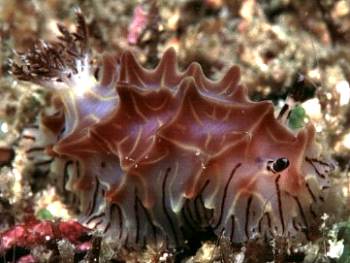
Dear Bill,
attached are 2 shots from the Philippines, Malapascua Island, divesite "Nudibranch City". Are they a very dark Halgerda willeyi, Halgerda wasinensis or something else?
Size approx. 2cm
depth 12 - 15m
date April 2002
The photos are by Georg Heinze [Georg.Heinze@t-online.de]
Cheers
Erwin
Erwin@medslugs.de
Koehler, E., 2002 (Oct 18) Halgerda from the Philippines. [Message in] Sea Slug Forum. Australian Museum, Sydney. Available from http://www.seaslugforum.net/find/8147Dear Erwin,
This is very similar to Fredy Brauchli's photo, also from the Philippines. My best guess is that it is a form of Halgerda willeyi.
Best wishes,
Bill Rudman
Re: Halgerda in temperate Australian waters?
October 7, 2002
From: Leander Wiseman
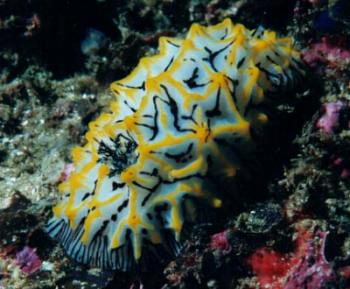
Hi,
I thought this photo of a Halgerda may be of interest. These Halgerda are regulars in Jervis Bay, New South Wales [Australia}. Is this likely to be Halgerda willeyi?
Regards
Leander Wiseman
leanderwiseman@yahoo.com
Wiseman, L., 2002 (Oct 7) Re: Halgerda in temperate Australian waters?. [Message in] Sea Slug Forum. Australian Museum, Sydney. Available from http://www.seaslugforum.net/find/8116Dear Leander,
Thanks for the photo. Animals from the New South Wales coast can sometimes be a problem to identify because we don't know whether they are a 'local endemic species' [that is found only in New South Wales] or whether they are members of a tropical species, which some to venture this far south as larvae in warm currents. My feeling is that this is a southern population of the tropical Halgerda willeyi. However there is still some confusion over how much colour variation we can expect to find in that species. If you look at the pages on Halgerda elegans and Halgerda cf. graphica you will see examples of other specimens from New South Wales which show similarities and differences to your animal.
Basically we still have to sort this problem out. The first thing that needs doing is comprehensive study of the New South Wales populations to see how variable the colour patterns are and whether there is more than one species.
Best wishes,
Bill Rudman
RE: Juvenile Halgerda sp. from Taiwan
July 18, 2002
From: Nishina Masayoshi
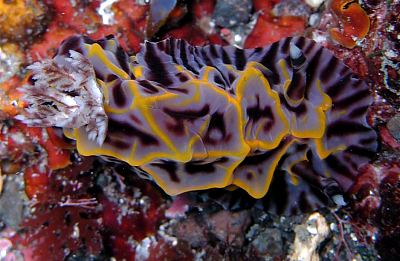
Dear Bill,
Todd Garthwaite's Juvenile Halgerda sp. from Taiwan recalls to me another my puzzle. I sometimes find Halgerda which are difficult to identify like in the upper photo. I've been wondering whether it's H.willeyi or H.wasinensis?
I feel my animal and Todd's animal looks the same. Both have the conspicuous prominent bright yellow ridges which don't look like those of H. elegans to me. It is difficult say something without seeing the rhinophores and the gill but I feel that
Todd's animal is more similar to H.willeyi or H.wasinensis then H. elegans. I have attached two more photos [lower] which I am also not sure of. I feel those are rather say similar to darker color form of H.willeyi.
Data: Hachijo Island Japan
Upper Right:30 June, 2001., Depth: 8m, Length:40mm
Lower Left: 02 Dec, 2001., Depth: 8m, Length:40mm
Loweer Right: 18 Dec, 2001., Depth: 8m, Length:50mm
Best Regards,
Nishina Masayoshi
nishina@wips.co.jp
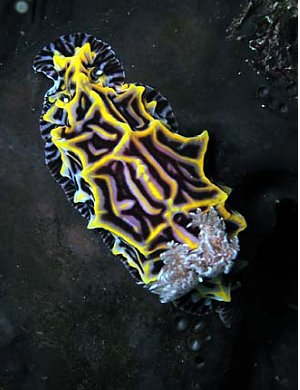
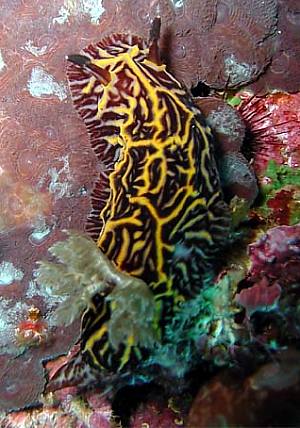
Dear Nishina,
It is almost impossible to identify little juveniles like this. You could be right in thinking Todd's animal is H. willeyi. Concerning your animals, have a look at the message showing a very dark animal and a much lighter one mating. I suspect all of the photos you have sent here are the same species. It is probably a form of Halgerda willeyi but I suspect this colour grouop needs further study. For example in your lower right photo the rhinophore stalks are black with a white line where normally you would expect a white stalk with a black line
Best wishes,
Bill Rudman
Halgerda iota? from Malaysia
July 12, 2002
From: Richard Houghton
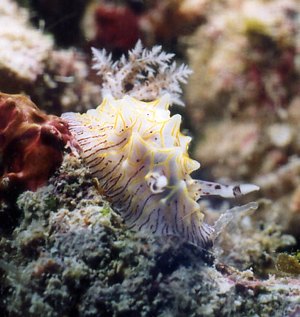

Bill,
Here are some photos of what I think is Halgerda iota from off Pulau Aur, Malaysia in May 2002.
Happy diving,
Rich
richard_houghton@hotmail.com
Houghton, R., 2002 (Jul 12) Halgerda iota? from Malaysia. [Message in] Sea Slug Forum. Australian Museum, Sydney. Available from http://www.seaslugforum.net/find/7468Dear Rich,
It could possibly be Halgerda iota Yonow, 1994 but I am not sure how to distinguish it from halgerda willeyi. It is of course possible that there are a number of species 'hiding' under the name 'H. willeyi'. Perhaps Shireen Fahey can give us her opinion.
Best wishes,
Bill Rudman
Halgerda willeyi? mating with???
May 2, 2002
From: Erwin Köhler
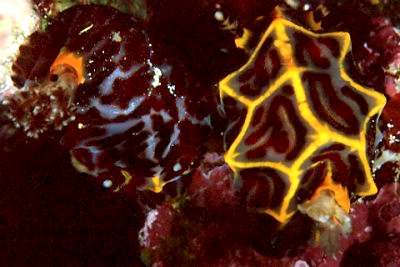
Dear Bill,
At Coon's website is a photo of 2 mating Halgerdas. The right one is Halgerda wasinensis, but who is the other one???
http://www2.gateway.ne.jp/~coon/slug-24.htm
. Bob Bolland wrote: "No idea at all about this... I've never seen a Halgerda this dark before."
Erwin
Erwin@medslugs.de
Köhler,E., 2002 (May 2) Halgerda willeyi? mating with???. [Message in] Sea Slug Forum. Australian Museum, Sydney. Available from http://www.seaslugforum.net/find/5246Dear Erwin,
Thanks for finding this photo. The owner of the website is Mr Naohisa Arai, who has given me permission to use his interesting photo.
Details are: Yaeyama Islands, Okinawa, Japan [Lat N 24 degrees Long E 124 degrees]. mid-May, 2001. Environment is a reef region at depth of 43ft.
I suspect this species is closer to H. willeyi then H. wasinensis. Typical H. wasinensis from East Africa has a black background and numerous thin ridges on the mantle. In H. willeyi there are a few ridges, and the background colour of the mantle is translucent white with black lines. In the animal on the right the black lines are a lot thicker than usual but if this is a melanistic variety that would be expected. In the animal on the left, which is mating with the other, the black lines are even broader, and the yellow lines along the ridges are absent.
Whether this is a form of H. willeyi or a separate species I wouldn't know, but there is again a clear lesson to be learned here - don't describe new species from a single specimen!
Best wishes,
Bill Rudman.
Halgerda willeyi? from the Adriatic
February 6, 2001
From: Tom Turk
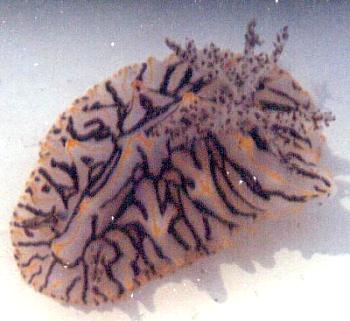
Dear Bill,
I am preparing a paper on the Opisthobranch mollusks of the Adriatic sea and a slide came to my attention showing a nudibranch that without much doubt belongs to the genus Halgerda. The specimen was photographed by my colleague France Velkovrh in July 1988. He collected the slug in the southernmost tip of the island Cres, near Baldarin Bay [Croatia, northern Adriatic sea, about 45 degrees North]. The specimen (4 cm in length) was found in mid summer (end of July) under a stone in 1 m deep water. The water temperature was about 25 degrees C. I discussed the finding with France who is reliable person, and a specialist on prosobranch molluscs, so any mismatch of the location is out of the question. He was also surprised by the finding, but did not pay particular attention since Nudibranchs have never been in the main focus of his research. I must emphasize that the area where the specimen had been found is very familiar to me. I have spent every summer there in the last 15 years. However, I must also say, that despite intensive diving in the area, including turning over many stones in the shallow water I never came across anything like this slug.
In my opinion the specimen is most probably Halgerda willeyi, Eliot 1903, but I would like to hear a second opinion. The specimen shows typical characteristics of the above species but also some differences. However, it is my understanding that different colour morphs of this species are quite common. As far as I know, this is the only record of any species of the tropical genus Halgerda in the Mediterranean sea. What is even more striking is the fact that the specimen was found far to the north of the Mediterranean basin.
There seems to me to be two reasonable explanations for its presence in the northern Mediterranean. There is an increasing number of Indo-Pacific species entering the Mediterranean through the Suez channel. A typical example within the mollusks is the large opisthobranch Bursatella leachi Blainville 1817 that has been found on several occasions even in the Gulf of Trieste and near Grado (De Min and Vio, 1998). There are many reports of this species from the coast of Turkey and Italy, some from up to 60 years ago. This clearly points to a slow but steady spreading of the species towards the north. In the case of a single finding of Halgerda willeyi such a distribution is less likely since this is the only record in the Mediterranean and was made 12 years ago. Since than, the warming of the Mediterranean sea is in progress but there are no new records of this species, not even from the southeastern Mediterranean basin where there are known to be larger numbers of lessepsian immigrants from the Red Sea. In the case of Halgerda willeyi I would think that distribution by means of ship ballast waters is more likely. In principle, its veliger larvae could survive in the northern Adriatic where during summer the surface water temperature easily matches that of tropical seas. One problem is the availability of an appropriate sponge, for metamorphosis and adult feeding. It is however possible that Halgerda willeyi is not a specialist and could survive by feeding upon locally available food. Marshall and Willan (1999) list Halgerda willeyi as a species that preys on different marine sponges and consider it as a non specialist
I would appreciate your comments and answers.
Best regards,
Tom Turk
tom.turk@uni-lj.si
Turk, T., 2001 (Feb 6) Halgerda willeyi? from the Adriatic. [Message in] Sea Slug Forum. Australian Museum, Sydney. Available from http://www.seaslugforum.net/find/3301Thanks Tom,
Firstly for those who don't know the term lessepsian, it is derived from Ferdinand De Lesseps who led the team that built the Suez Canal, thus linking the Red Sea with the Mediterranean. Lessepsian migration refers to species which have entered the Mediterranean, from the Red Sea, through the Suez Canal.
This is an extremely interesting record. It seems to be Halgerda willeyi. I agree that ballast water is a very reasonable suggestion for explaining its presence in the Adriatic. Concerning its sponge food, have a look at the page on the New Zealand Rostanga muscula. I discuss there its liking for an introduced European sponge which made itself at home for 3 years in Auckland Harbour. This reinforces the suggestion that Halgerda could either have found a local sponge to its liking, or that a suitable sponge also made the journey in ballast tanks, and made itself at home in the Adriatic, perhaps for a short time.
Best wishes,
Bill Rudman
Halgerda willeyi? from Philippines
July 12, 2000
From: Fredy Brauchli
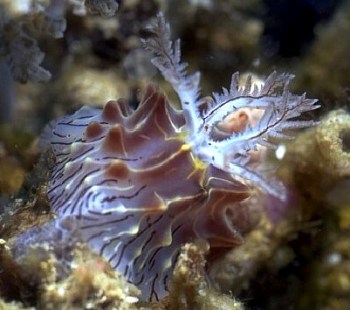
Hello Bill
I am a Swiss scuba diver and hobby photographer and I like sea slugs very much.
In April this year I found on the island of Negros (Philippines) at a place called "Broccoli" Reef a specimen which looks similar to Halgerda willeyi. It is a small animal of about 8 - 10 mm.
Can you identity this slug?
Thanks very much for your help.
Kind regards from Switzerland
Fredy Brauchli
http://www.subaqua.ch
brauchli@subaqua.ch
Brauchli, F., 2000 (Jul 12) Halgerda willeyi? from Philippines. [Message in] Sea Slug Forum. Australian Museum, Sydney. Available from http://www.seaslugforum.net/find/2688Dear Fredy,
I am pretty sure this is Halgerda willeyi. The papillae on its back, where the ridges join, are very elongate but I think this is a juvenile character. There are a number of people working on Halgerda at the moment so I am sure we will hear from them if I am wrong.
Best wishes,
Bill Rudman.
Halgerda willeyi from Taiwan
March 8, 2000
From: Bernard Picton
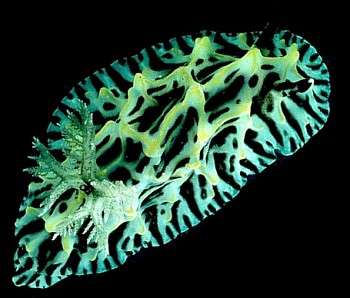
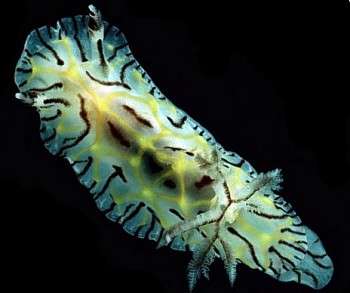
Bill,
Here are two specimens which I think must be Halgerda willeyi - both from Taiwan (Formosa) in 1983. In view of the recent doubt re. the name formosa ..... I haven't seen the description of H. formosa or the recent paper but I hope Terry & Shireen have it right now! The smaller individual I have seen has far fewer dark makings than the larger one. I could look up my notes to get the sizes if that's important.
Cheers,
Bernard
bernard.picton.um@nics.gov.uk
Picton, B., 2000 (Mar 8) Halgerda willeyi from Taiwan. [Message in] Sea Slug Forum. Australian Museum, Sydney. Available from http://www.seaslugforum.net/find/2013Dear Bernard,
Yes I think this is H. willeyi which has a wide Indo-West Pacific distribution.
The name 'formosa' doesn't actually refer to the Formosa (Taiwan), it was originally described from Reunion Id in the Indian Ocean. I am pretty sure 'formosa' means sweet or beautiful and I have this vague memory that it was this meaning that some early European explorer applied to Taiwan - because of some sweet smelling spices or perfume.
I have included the original colour figures of Halgerda formosa from Bergh, in my comments on your photo of Halgerda formosa.
Best wishes,
Bill Rudman.
Halgerda willeyi from the Philippines
March 8, 2000
From: Bernard Picton
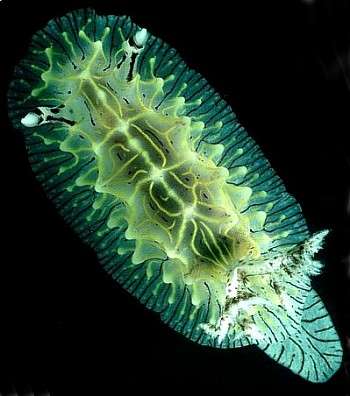
Hello Bill,
Here is a picture of a specimen which I now suspect to be H. graphica - Willan and Coleman have a picture of a very different looking animal as H. graphica but this one seems very like the drawing in the original description - in particular it has the main reticulate pattern of ridges but also a series of curved, darker yellow lines in the areas between the ridges and dark markings there also. Also from the Philippines in 1983.
Bernard.
bernard.picton.um@nics.gov.uk
Picton, B., 2000 (Mar 8) Halgerda willeyi from the Philippines. [Message in] Sea Slug Forum. Australian Museum, Sydney. Available from http://www.seaslugforum.net/find/2051Dear Bernard
Your animal looks quite like Halgerda elegans, with the radiating black lines on the mantle skirt. I have added a page for comparison. I have also added a copy of Bergh's original colour plates. Your photo also looks quite like H. graphica . Both were described in 1905. If they are the same we will need to know which was published first to determine which name to use.
There is one difference between H. elegans and your photo and that is the colour of the rhinophore clubs. In H. elegans the club is essentially black whereas in your animal th club is white with a black band around the midregion. This is the same colour as found in Halgerda willeyi, which I think your animal is.
Best wishes,
Bill Rudman.
Halgerda willeyi from Mooloolaba?
June 17, 1998
From: Wayne Ellis
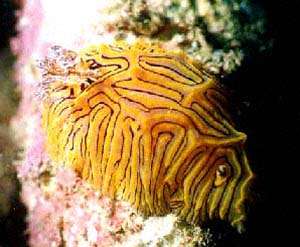
Hi Bill,
I've attached a pic of what I believe may be Halgerda willeyi. Am I close? Steve Grail found it off Mooloolaba, Sunshine Coast, southern Queensland, May 1998. That's all I know at present.
Regards
Wayne Ellis
glaskin@ozemail.com.au
Ellis, W., 1998 (Jun 17) Halgerda willeyi from Mooloolaba?. [Message in] Sea Slug Forum. Australian Museum, Sydney. Available from http://www.seaslugforum.net/find/68Thanks Wayne. Yes this is Halgerda willeyi. The genus Halgerda contains some of the most spectacularly shaped and coloured of the dorids. The mantle is very firm and smooth and is usually elaborated into a network of ridges, which are often pronounced and strongly angled. The ridges radiate out from a series of tubercles scattered over the body. The gills are usually very large, but very sparse, with few lamellae or leaflets along each arm. Halgerda willeyi was originally collected at Lifu, Loyalty Ids, New Caledonia by Dr Willey's pioneering expedition to study the biology of living Chambered Nautilus. It is probably the most common species of Halgerda found in New Caledonia. Species in the genus are usually differentiated by their colour patterns. At present it is difficult to determine whether Halgerda willeyi has a very variable colour pattern or whether there are a number of very similarly coloured species. It is well-known in eastern Australia, East Africa and the Red Sea, so I assume it occurs throughout the Indo-West Pacific ... Bill Rudman
Rudman, W.B., 1998 (Jun 17). Comment on Halgerda willeyi from Mooloolaba? by Wayne Ellis. [Message in] Sea Slug Forum. Australian Museum, Sydney. Available from http://www.seaslugforum.net/find/68